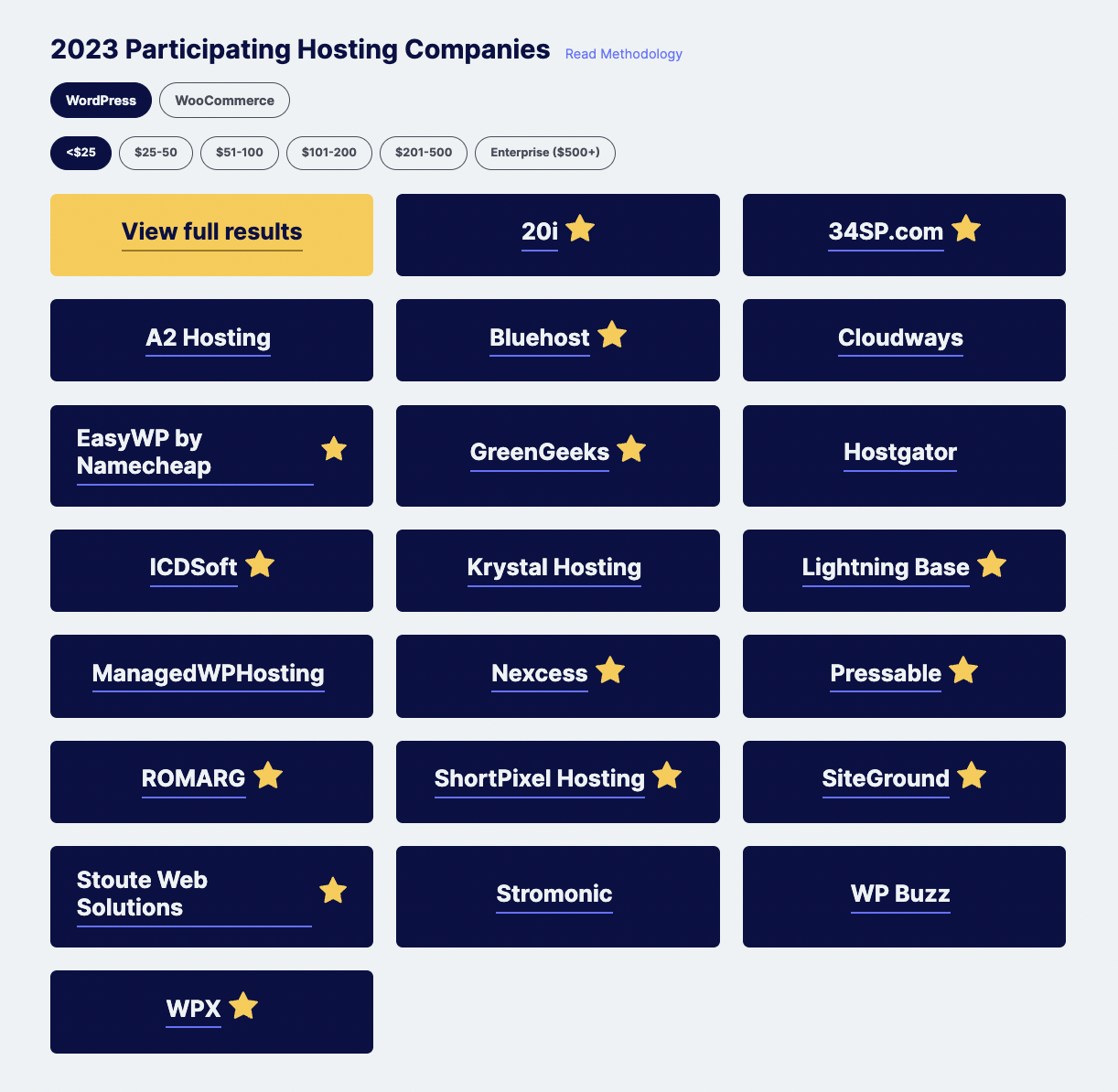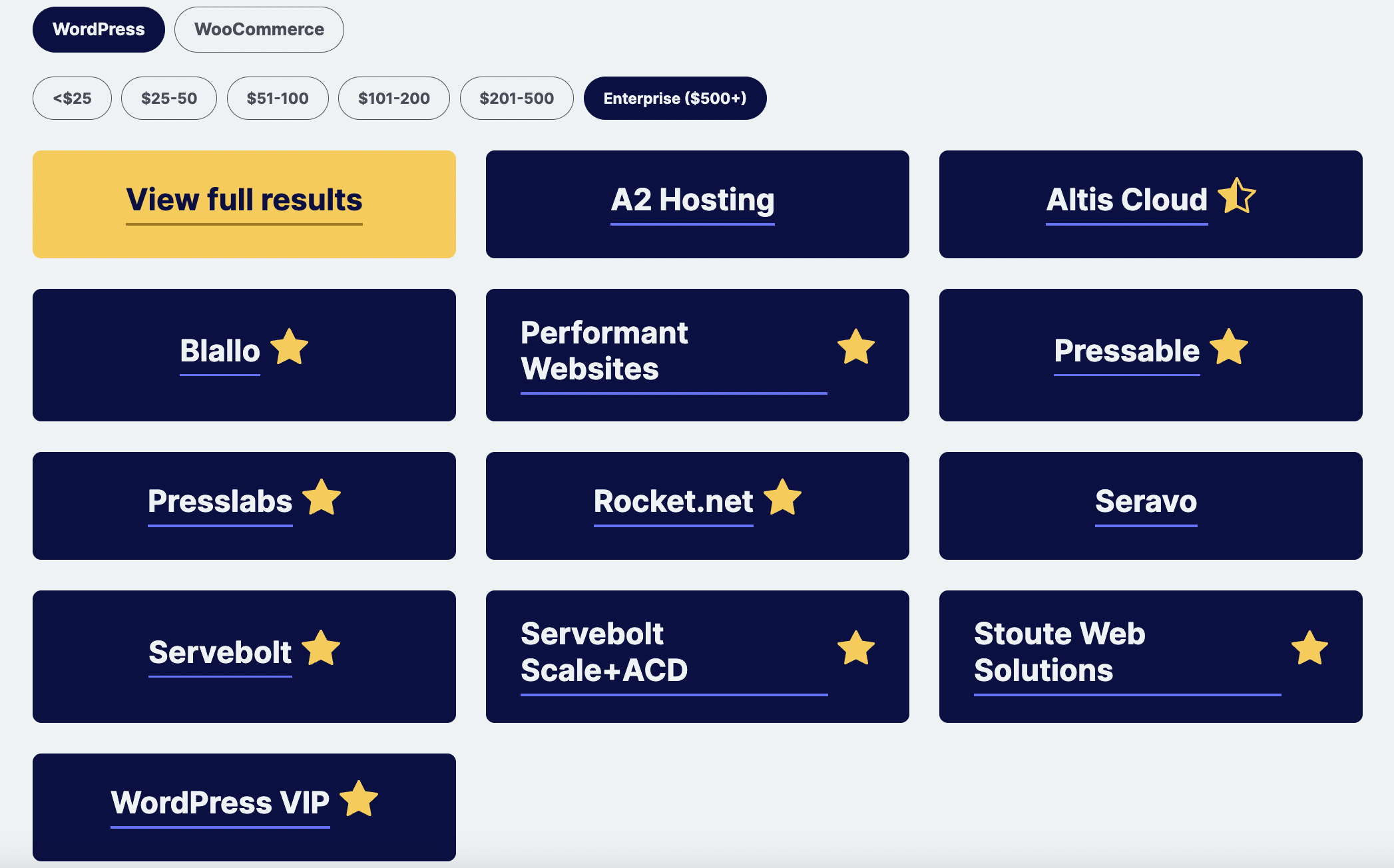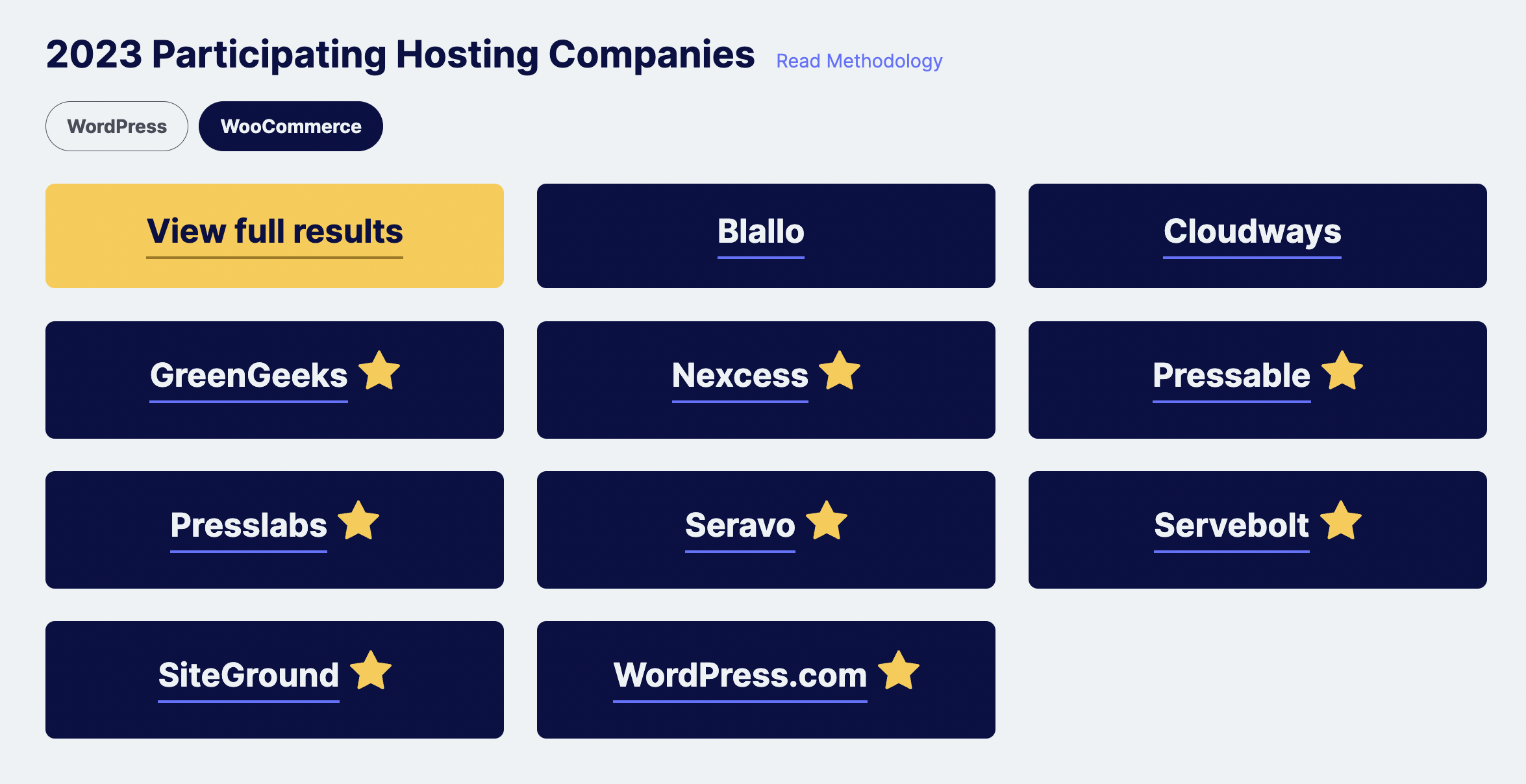Kevin Ohashi from Review Signal has published his 2023 WordPress and WooCommerce hosting performance benchmarks. This is his 10th round of capturing performance data from hosting companies that opt into the testing. Ohashi’s methodology tests two metrics through a variety of methods: peak performance and consistency.
The benchmarks include a LoadStorm test designed to simulate real users visiting the site, logging in, and browsing (uncached performance). They also test cached performance, SSL, WP queries per second, performance on some computational and database operations, and a WebPageTest that fully loads the homepage and records how long it takes from 12 different locations around the world. As part of the consistency testing, Ohashi also measures uptime using HetrixTools and Uptime Robot for a minimum of three months.
Participants pay a standard, publicly documented fee, based on the price tier of the product being tested, to cover the costs. Ohashi does not accept sponsorships for the tests, and has become one of the most trusted sources for unbiased performance reviews of WordPress hosting plans.
In 2023, Ohashi tested 31 companies across 72 plans and seven pricing tiers, with tests nearly identical to previous years. He made minimal adjustments to the LoadStorm test script to improve performance and make it compatible with newer versions of k6.
The website makes it easy to review results at a glance by using a star system. Hosts that achieve “Top Tier” status receive a full star:
This is awarded to companies who maintain 99.9% uptime throughout the entire testing and show little to no performance degradation during load testing, primarily focused on error rate and consistent response times. Error rates above 0.1% and response times above 1000ms* will keep a company away from achieving Top Tier marks.
The half star indicates “Honorable Mention” status, which is given to companies that came close to Top Tier but fell just short, such as struggling slightly on a load test.
Among budget hosts in the <$ 25/month category, the majority of hosts (16/21) rang in at the Top Tier level. Those who did not earn Top Tier status were held back by inferior performance on the the LoadStorm test for the most part, even though several still took top scores in other aspects of the testing.

There are fewer participants at the $ 25-50 plan (and other more expensive plans) but the results are similar to the budget hosts, with A2 Hosting, Cloudways, and Stromonic edged out of contention for Top Tier. All three failed to achieve Top Tier for any of the plans tested this year.
In the Enterprise tier ($ 500+), the majority of participants handled the LoadStorm test without issue. When testing cached performance, Ohashi found that the overall field of participants is getting faster:
Excluding Seravo, every company was 33ms average or below and 43ms p95 or below. Compared to last year where the fastest average was 6.4 ms and p95 was 20ms. There are four companies this year below both of those levels. The performance at the Enterprise tier is mind bogglingly fast and getting even faster which is hard to comprehend when last year’s 6.4ms was beaten by 4 plans this year.

Most of the entrants in the WooCommerce category earned Top Tier status, with the exception of Blallo and Cloudways, both of which stumbled on the LoadStorm test. The hosting plans tested range from $ 25.95/month – $ 99/month. The WooCommerce-specific tests collect average response times, total requests, errors, and other metrics across four different profiles:
- Profile 1 (20%): Buyer – Homepage, add item to cart, go to cart, checkout (doesn’t submit order)
- Profile 2 (10%): Customer (existing) – Homepage, login, view orders, view account details
- Profile 3 (20%): Browser – Homepage, visit 5 random product pages
- Profile 4 (50%): Home – Homepage only
A more detailed breakdown is available on the WooCommerce benchmarks results page.

It’s important to note that the tests do not clearly identify a winner or top performer. They also don’t take into account other aspects of the WordPress hosting experience, like reviews, support, and features. Ohashi tests the defaults for all of these plans, but if there are more optimization features that can be customized for sites (which are not clearly outlined in the initial setup) then those are also not taken into account. The methodology simply focuses on performance, so it’s just one factor of hosting, albeit a very important one.
“As far as surprising results, I keep thinking ‘Are we nearing the point that we won’t see much improvement?’ and each year the whole field gets faster and faster,” Ohashi said. “Even improving on sub 10ms times between years. For example, in the <$ 25/month tier, in 2022 there were 3 companies with <50ms average response time on the Static k6 test. This year there are 10. I also saw 100ms+ improvements from the other (slower) side bringing up the whole field a meaningful amount. Everyone is getting faster and faster.”
Why Are Some Managed WordPress Hosting Companies Missing?
There are many leading WordPress managed hosts that are notably absent from Ohashi’s benchmarks, whose inclusion would be helpful for a deeper understanding of market. I asked him about a handful of them and he reported that WP Engine, Dreamhost, and Kinsta declined to participate this year, to name a few. GoDaddy took a year off but may be back next year.
The major reasons for hosts not wanting to participate fall into a few categories, and bad performance is chief among them.
“Some companies perform poorly or poorly relative to price and don’t want to participate anymore,” Ohashi said. “They usually talk about other ‘intangible’ values that you can’t measure. I think good performance should be a default for every hosting company, and good companies shouldn’t be afraid of bad results – if they actually plan on improving their services.
“But some would probably rather spend fortunes on marketing instead of better engineering, and bad results aren’t going to help their marketing. I personally love seeing companies who participate year after year despite mixed results. I respect the companies who consistently earn Top Tier are doing a great job. But there’s something special about companies willing to put themselves out there regardless of the results, because it’s a public and open commitment to improving.”
Ohashi said that occasionally the timing doesn’t work out where a host is going through a major engineering overhaul during the testing and doesn’t want the platform benchmarked when they are about to release a new one. In this case some opt to skip a year.
The costs of the benchmarking can also be prohibitive for some smaller hosting companies. Ohashi raised prices by $ 250 across all tiers this year (eg. $ 100->$ 350, $ 500->$ 750) to cover his costs. Although this doesn’t seem like much for a hosting company, they also have to pay for the servers for four months, and have the staff/resources available to work with Ohashi on organizing, executing, and debugging issues. 20i, Krystal Hosting, Nexcess, and Pressable agreed to sponsor upstart companies in the space for 2023.
Another reason some hosts don’t participate is a lack of interest or value. They don’t see how they can use the benchmark results to their advantage.
“Some companies don’t get as much value from the benchmarks as others,” Ohashi said. “Performance across the board has gone way up. It’s harder and harder to stand out.
“I think some companies may view it as an instant validation and reason for customers to come busting down the doors. But there are a lot of great companies offering great performance. Earning Top Tier status means you’ve got a performant hosting platform. It’s great, and it can help validate some customer needs/desires in the decision making funnel, but it won’t magically generate tons of sales.”
Ohashi said he has put together notes for hosting companies that earned Top Tier status to help them leverage more value this year from a marketing perspective, based on what he has seen some companies do with their results. Creating more value for participating companies is something he is actively working to improve upon.
Although Review Signal had approximately 35,000 people visit in the past year, Ohashi doesn’t think the traffic captures the full value of the benchmarks very well. The people who dig into these metrics are those who have a large impact on where their WordPress clients host their websites.
“The people who care about the benchmarks are seriously into WordPress / hosting / performance,” Ohashi said. “It’s a lot of agencies, developers, large website owners and hosting people. One way I’ve measured impact is by going to the major WordCamps (EU/Asia/US) and talking to people. The number of folks who are aware of the benchmarks there was surprisingly high to me. The people who are interested enough to spend time at WordCamps are the same folks interested in reading the benchmarks. It’s not the largest number of people who read them, but it is the largest impact people who read and value them.”
WP Tavern



Leave a Reply
You must be logged in to post a comment.